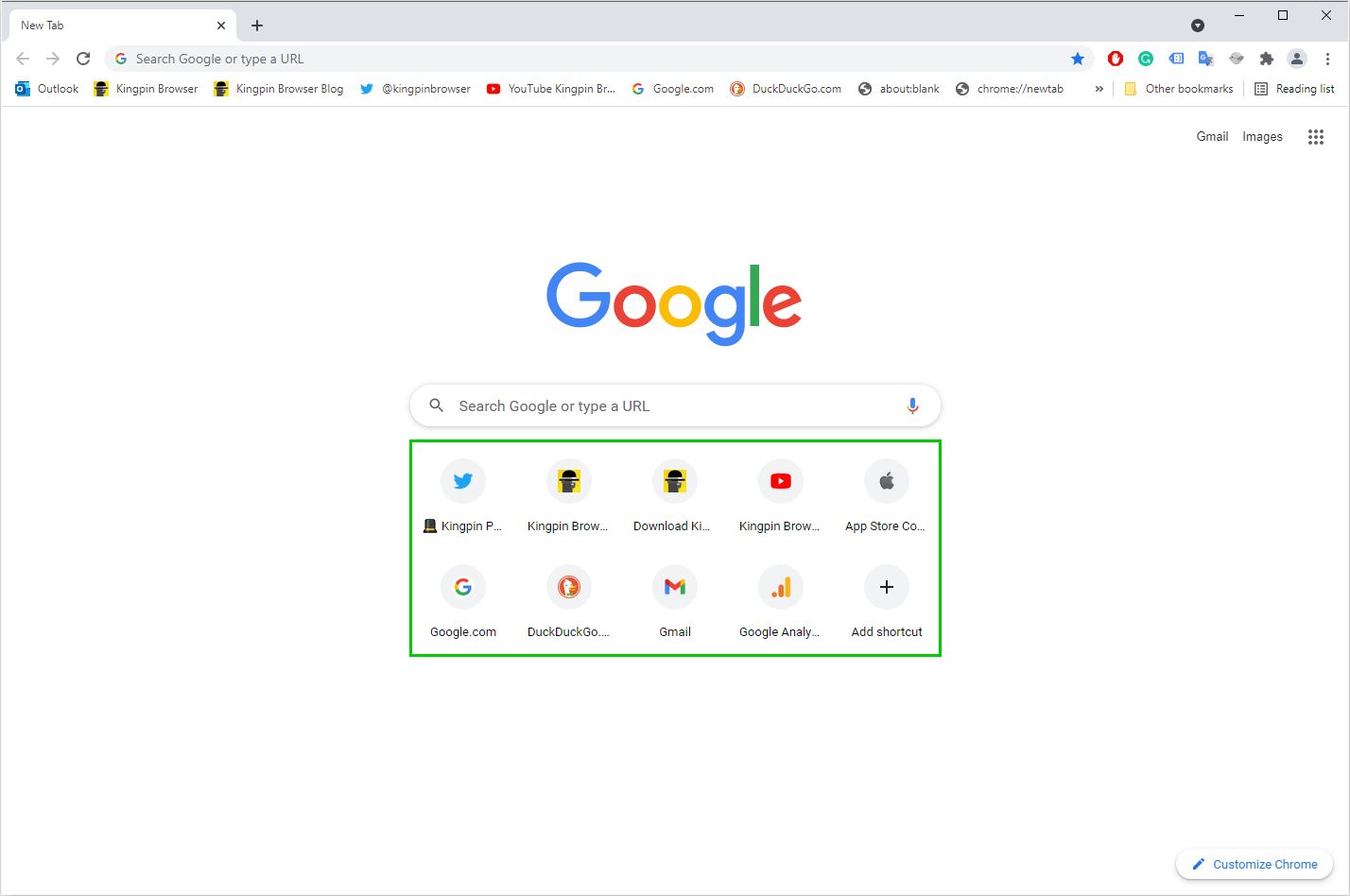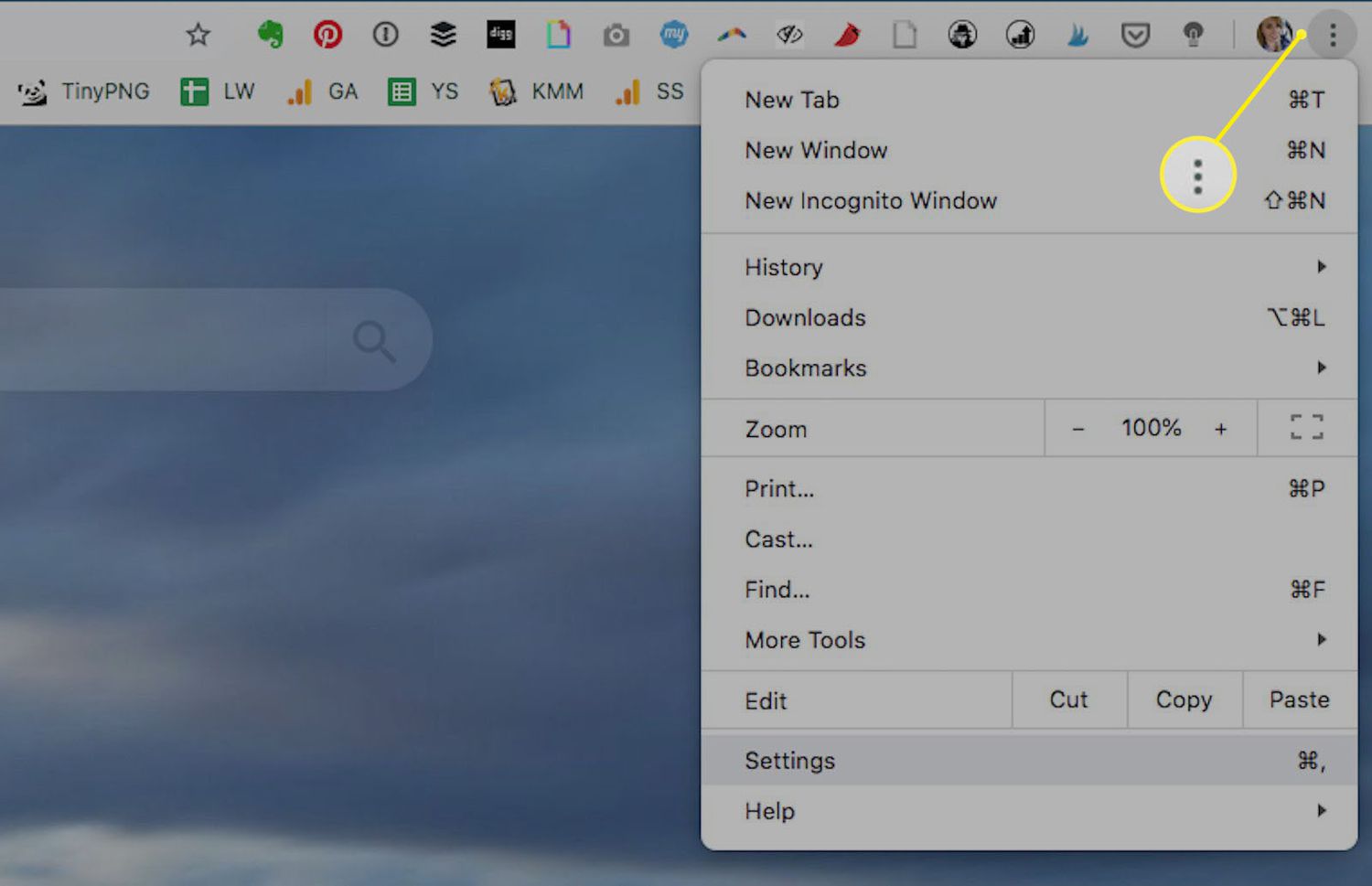Introduction
Google Chrome is one of the most popular web browsers, known for its speed, simplicity, and user-friendly interface. It offers a seamless browsing experience and a wide range of features, including the ability to customize the browser with various extensions and themes. However, users may encounter issues with Chrome, such as missing or broken thumbnails on the New Tab page. This can be frustrating, especially for those who rely on visual cues to access their frequently visited sites quickly.
In this article, we will explore the common causes of missing thumbnails on Google Chrome and provide step-by-step solutions to restore them. Whether you're a casual user or a tech-savvy individual, understanding how to address this issue can help you optimize your browsing experience and make the most of Chrome's features.
So, if you've noticed that the thumbnails on your Chrome New Tab page have disappeared or become distorted, don't worry – we've got you covered. By following the troubleshooting steps outlined in this guide, you can regain access to your favorite sites and ensure that your Chrome browser is functioning smoothly. Let's dive into the details and get your Chrome thumbnails back to their pristine state!
Understanding the Issue
The New Tab page in Google Chrome is designed to display visually appealing thumbnails of frequently visited websites, allowing users to access their preferred sites with just a single click. However, it's not uncommon for users to encounter a situation where these thumbnails are missing or appear as generic placeholders. This issue can be attributed to various factors, and understanding the underlying causes is crucial to effectively resolving it.
One common reason for missing thumbnails on the New Tab page is a temporary glitch or error within the browser. This can occur due to a variety of factors, including software conflicts, outdated browser versions, or corrupted cache data. Additionally, if Chrome's settings have been altered or if certain extensions are causing conflicts, it can lead to the disappearance of thumbnails.
Furthermore, network connectivity issues or server-side problems can also impact the retrieval of thumbnail images, resulting in blank or broken placeholders on the New Tab page. In some cases, the problem may be specific to certain user profiles, indicating a localized issue within Chrome's configuration.
It's important to note that while missing thumbnails may seem like a minor inconvenience, they can significantly disrupt the browsing experience, especially for users who heavily rely on visual cues to navigate the web efficiently. As such, addressing this issue promptly is essential to ensure a seamless and visually appealing New Tab page.
By gaining a comprehensive understanding of the potential causes behind missing thumbnails on Google Chrome, users can approach the troubleshooting process with clarity and confidence. In the following sections, we will explore practical steps to diagnose and resolve this issue, empowering users to restore the functionality of their New Tab page and enhance their browsing experience.
Checking for Updates
Ensuring that Google Chrome is running the latest version is a fundamental step in troubleshooting the issue of missing thumbnails on the New Tab page. Chrome frequently releases updates to address bugs, improve performance, and introduce new features. By checking for updates, users can leverage the latest enhancements and bug fixes that may directly impact the display of thumbnails.
To begin, users should navigate to the Chrome menu, represented by three vertical dots in the top-right corner of the browser window. From the menu, select "Help" and then click on "About Google Chrome." This action triggers Chrome to initiate an automatic check for updates. If an update is available, Chrome will proceed to download and install it.
Upon completion of the update process, users should restart the browser to ensure that the changes take effect. It's important to note that Chrome may prompt users to relaunch the browser to apply the update, and it's advisable to comply with this request to ensure seamless integration of the latest version.
By keeping Chrome up to date, users can benefit from improved stability, security enhancements, and potential bug fixes that may directly impact the display of thumbnails on the New Tab page. Additionally, staying current with updates aligns with best practices for maintaining a secure and optimized browsing environment.
In the event that the issue persists even after updating Chrome, users can proceed to explore additional troubleshooting steps to address the missing thumbnails. However, checking for updates serves as an essential initial action to ensure that the browser is equipped with the latest improvements and optimizations, potentially resolving the issue without the need for further intervention.
In summary, checking for updates in Google Chrome is a straightforward yet crucial step in troubleshooting the issue of missing thumbnails on the New Tab page. By staying proactive in keeping the browser up to date, users can harness the full potential of Chrome's features and enhancements, contributing to a seamless and visually engaging browsing experience.
Clearing the Cache
Clearing the cache in Google Chrome can effectively address various browsing issues, including the disappearance of thumbnails on the New Tab page. The browser's cache stores temporary data, such as images and web page elements, to facilitate faster loading times upon revisiting websites. However, a corrupted or outdated cache can lead to display anomalies, including missing or distorted thumbnails.
To clear the cache in Google Chrome, users can follow these simple steps:
-
Accessing Chrome Settings: Begin by clicking on the Chrome menu, denoted by three vertical dots in the top-right corner of the browser window. From the menu, select "Settings" to access the browser's configuration options.
-
Navigating to Clear Browsing Data: Within the Settings menu, scroll down and click on "Privacy and security." Under this section, select "Clear browsing data" to proceed to the cache clearing interface.
-
Selecting Cache Data: In the Clear browsing data menu, users can choose the time range for which they want to clear the cache. To ensure a comprehensive clearing process, it's advisable to select "All time" to remove all cached data accumulated over the browser's entire usage history.
-
Clearing the Cache: Once the appropriate options are selected, users can click on "Clear data" to initiate the cache clearing process. Chrome will proceed to remove the cached images and files, effectively resetting the browser's cache to a clean state.
-
Restarting Chrome: After clearing the cache, it's recommended to restart the browser to ensure that the changes take effect. Users can simply close and reopen Chrome to complete the process.
By clearing the cache in Google Chrome, users can eliminate potential data inconsistencies that may be contributing to the issue of missing thumbnails on the New Tab page. This action effectively refreshes the browser's cache, allowing it to reacquire and display the appropriate thumbnail images for frequently visited websites.
In the event that the issue persists after clearing the cache, users can proceed to explore additional troubleshooting steps to restore the functionality of the New Tab page. However, clearing the cache serves as a proactive measure to address potential data-related anomalies and optimize the browsing experience within Google Chrome.
In summary, clearing the cache in Google Chrome is a straightforward yet impactful step in troubleshooting the issue of missing thumbnails on the New Tab page. By periodically clearing the cache, users can maintain a streamlined browsing environment and mitigate potential display inconsistencies, contributing to an enhanced and visually appealing browsing experience.
Resetting Chrome Settings
Resetting Chrome settings can serve as a comprehensive solution to address a wide range of browsing issues, including the persistent problem of missing thumbnails on the New Tab page. This process effectively restores Chrome to its default state, eliminating potential configuration conflicts and discrepancies that may be contributing to the display anomalies.
To initiate the reset of Chrome settings, users can follow these step-by-step instructions:
-
Accessing Chrome Settings: Begin by clicking on the Chrome menu, denoted by three vertical dots in the top-right corner of the browser window. From the menu, select "Settings" to access the browser's configuration options.
-
Navigating to Advanced Settings: Within the Settings menu, scroll down and click on "Advanced" to reveal additional configuration options.
-
Resetting Chrome Settings: Under the "Reset and clean up" section, select "Restore settings to their original defaults." This action will prompt Chrome to display a confirmation dialog outlining the changes that will occur as a result of the reset.
-
Confirming the Reset: Upon reviewing the implications of the reset, users can proceed by clicking on "Reset settings." Chrome will then proceed to reset its configuration to the default state, effectively eliminating potential conflicts and discrepancies.
-
Restarting Chrome: After resetting the browser settings, it's recommended to restart Chrome to ensure that the changes take effect. Users can simply close and reopen the browser to complete the process.
By resetting Chrome settings, users can effectively eliminate potential configuration conflicts, extensions-related issues, and other discrepancies that may be impacting the display of thumbnails on the New Tab page. This action provides a comprehensive reset of the browser's settings, potentially resolving the issue and restoring the seamless functionality of the New Tab page.
In the event that the problem persists even after resetting Chrome settings, users can proceed to explore additional troubleshooting steps to address the missing thumbnails. However, resetting Chrome settings serves as a proactive measure to eliminate potential configuration conflicts and discrepancies, contributing to a streamlined and visually engaging browsing experience within Google Chrome.
In summary, resetting Chrome settings is a fundamental yet impactful step in troubleshooting the issue of missing thumbnails on the New Tab page. By restoring the browser to its default state, users can effectively address potential configuration anomalies and optimize the browsing experience, ensuring that the New Tab page displays visually appealing thumbnails of frequently visited websites.
Reinstalling Chrome
In some cases, the issue of missing thumbnails on the New Tab page in Google Chrome may persist despite attempting various troubleshooting methods. When conventional solutions fail to restore the functionality of the browser, reinstalling Chrome can serve as a comprehensive approach to address underlying issues and ensure a clean, optimized installation.
Reinstalling Chrome involves removing the existing installation from the user's system and then downloading and installing a fresh copy of the browser. This process effectively eliminates potential software conflicts, corrupted files, or persistent anomalies that may be contributing to the display issues experienced on the New Tab page.
To reinstall Google Chrome, users can follow these step-by-step instructions:
-
Uninstalling Chrome: Begin by navigating to the control panel or system settings on the user's device. From the list of installed programs or applications, locate Google Chrome and select the option to uninstall the browser. It's important to ensure that all associated files and settings are removed during the uninstallation process.
-
Downloading the Installer: After successfully uninstalling Chrome, users can proceed to download the latest version of the browser from the official Chrome website. The installer file can be obtained from the Chrome download page, and users should ensure that they download the appropriate version for their operating system.
-
Installing Chrome: Once the installer file is downloaded, users can initiate the installation process by running the executable file. The installation wizard will guide users through the setup, allowing them to customize certain preferences and settings before completing the installation.
-
Importing Bookmarks and Settings: If users had previously synced their Chrome data or exported their bookmarks, they can import this data back into the newly installed browser. This ensures that their personalized settings and browsing data are retained after reinstalling Chrome.
-
Verifying Thumbnail Display: After reinstalling Chrome and importing any necessary data, users can verify the functionality of the New Tab page to ensure that the thumbnails of frequently visited websites are displayed correctly. This step allows users to confirm that the reinstallation process has effectively resolved the issue of missing thumbnails.
Reinstalling Chrome provides a comprehensive approach to addressing persistent issues related to missing thumbnails on the New Tab page. By removing the existing installation and installing a fresh copy of the browser, users can effectively eliminate potential software conflicts and corrupted files, ensuring a clean and optimized browsing environment within Google Chrome.
In summary, reinstalling Chrome represents a proactive and comprehensive troubleshooting method to address persistent issues with missing thumbnails on the New Tab page. This approach allows users to achieve a clean installation of the browser, potentially resolving underlying anomalies and optimizing the browsing experience within Google Chrome.
Conclusion
In conclusion, the issue of missing thumbnails on the New Tab page in Google Chrome can be a frustrating experience for users who rely on visual cues to navigate the web efficiently. Throughout this comprehensive troubleshooting guide, we have explored various methods to diagnose and address this issue, empowering users to restore the functionality of their Chrome browser and enhance their browsing experience.
By understanding the potential causes behind missing thumbnails, users can approach the troubleshooting process with clarity and confidence. From checking for updates to reinstalling Chrome, each step serves as a proactive measure to address the underlying factors that may be contributing to the display anomalies on the New Tab page.
Checking for updates emerged as a fundamental initial step, ensuring that Chrome is equipped with the latest enhancements and bug fixes that may directly impact the display of thumbnails. By staying proactive in keeping the browser up to date, users can harness the full potential of Chrome's features and optimizations, contributing to a seamless and visually engaging browsing experience.
Clearing the cache in Google Chrome serves as a proactive measure to address potential data-related anomalies and optimize the browsing experience. This action effectively refreshes the browser's cache, allowing it to reacquire and display the appropriate thumbnail images for frequently visited websites.
Resetting Chrome settings provides a comprehensive approach to address potential configuration conflicts, extensions-related issues, and other discrepancies that may be impacting the display of thumbnails on the New Tab page. By restoring the browser to its default state, users can effectively address potential configuration anomalies and optimize the browsing experience, ensuring that the New Tab page displays visually appealing thumbnails of frequently visited websites.
In some cases, when conventional solutions fail to restore the functionality of the browser, reinstalling Chrome can serve as a comprehensive approach to address underlying issues and ensure a clean, optimized installation. This process effectively eliminates potential software conflicts, corrupted files, or persistent anomalies that may be contributing to the display issues experienced on the New Tab page.
By following the troubleshooting steps outlined in this guide, users can regain access to their favorite sites and ensure that their Chrome browser is functioning smoothly. Whether you're a casual user or a tech-savvy individual, understanding how to address this issue can help you optimize your browsing experience and make the most of Chrome's features.
In the ever-evolving landscape of web browsing, encountering technical issues is not uncommon. However, armed with the knowledge and practical solutions provided in this guide, users can navigate and overcome the challenges associated with missing thumbnails on the New Tab page, ensuring a seamless and visually engaging browsing experience within Google Chrome.

























